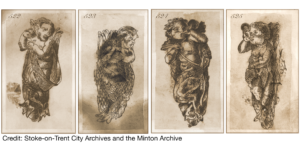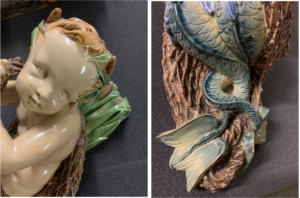Young Nix and Young Faun
ceramic
Albert-Ernest Carrier-Belleuse
French, 1824 – 1887
The Minton Company
English, c 1859
It has been said that the Industrial Revolution robbed the common people of beauty. Leaving the verdant countryside, they moved to cramped cities, worked in dingy factories, and lived in bare housing. Prince Albert, the progressive-thinking consort of Britain’s Queen Victoria, desired a change for his hard-working countrymen. But the beautiful, unique pieces that surrounded aristocrats were expensive. Could not everyday, practical items be beautiful? Could they be mass produced inexpensively? Since one must have a teapot, could it be functional, affordable, and beautiful?
Although Prince Albert addressed the lack of beauty on several fronts, he saw ceramics as part of the answer. At the Great Exposition of London (1851), primarily organized by Prince Albert, a “Ceramics Court” displayed large and small, elaborately decorated, English-made pieces. Exhibits from many countries also featured their unique ceramics. At booths and shops near the Crystal Palace everything from embellished ceramic teapots to ornate chamber pots could be purchased for “reasonable prices.”
Lending royal clout to the Victorian ceramic boom, Prince Albert purchased ceramic brackets matching those in M&G’s collection. They were passed down in the family and today belong to Queen Elizabeth.
Manufacturer: The Minton Company
From humble beginnings in Stoke-upon-Trent (1793), the Minton Company developed procedures and glazes that permitted them to became one of Europe’s leading ceramicists of the Victorian era. What was originally called Palissy-ware and later Victorian majolica won top prizes for “beauty and originality of design” at the Great Exposition and later international exhibitions as well. The company produced decorative tiles and sculpture for major buildings, including the Palace of Westminster and the US Capitol.
In time the Minton Company dwindled and eventually merged with other firms. The Minton Archive, which contains drawings of the pieces the company produced, remains intact. The records reveal that shape 524 is a pen and ink drawing of M&G’s Faun bracket, labeled “Bracket—Hunting.” Shape 522 is M&G’s Nix (or merbaby) bracket, labeled “Bracket—Fishing.”
The Archive has a pair of Hunting brackets (525 labeled “Companion Bracket—Hunting”) and a pair of Fishing brackets (523 “Companion Bracket—Fishing”). Both Hunting bracket fauns appear to be male. However, different hair lengths indicate Fishing 522 merbaby is male, and 523 is female.
Sculptor: Albert-Ernst Carrier-Belleuse
Albert-Ernest Carrier-Belleuse was a prolific 19th-century French sculptor. At age 13 he apprenticed to a goldsmith and learned precision and honed his technique. This enabled him to produce pieces with unusual forms and detail that were able to be mass-produced. He produced monumental statues, portrait busts and a wide array of decorative objects. His works vary from stark realism to ornate neo-Baroque and frequently combine several artistic styles.
In the mid-1800s political turmoil caused a number of artists to leave France. Carrier-Belleuse went to England in 1850 and became “modeling master” at two art schools. He was also employed as a sculptor by the Minton Company. During his 5-year English sojourn he sculpted for other ceramic firms, including Minton’s competitor, Wedgewood. Returning to France his reputation grew, and he was appointed to prestigious positions in the art world.
Astute in business, Carrier-Belleuse maintained a large studio producing copies and variations of his works. He passed on his artistic techniques and business practices to his students, including Rodin, Dalou and Falguière. He also sold reproduction rights for various of his designs to other manufacturers. The Minton Company appears to have had exclusive reproduction rights for his Hunting and Fishing brackets.
In the mid-1800s chubby infants were in vogue and are in a number of Carrier-Belleuse works. It was, however, unusual to combine infants with non-human features, as seen in the Hunting and Fishing brackets.
M&G’s Brackets
M&G’s Hunting bracket is a 19-inch faun, blowing a hunting horn over his left shoulder. On the infant’s waist is a draped, grey animal skin, which also forms the background for his lower body. Over his right shoulder he holds the feet of a fox. The head and front legs of the fox are draped around his neck to the faun’s left side. Below the knee the faun has crossed goat legs, typical of this mythological creature. In his hair and behind his head are oak leaves and acorns. Stamped into the reverse is “MINTON” and shape number “524.”
 M&G’s Fishing bracket is a 19-inch, male merbaby. He holds a brown fishing net over his right shoulder. It is then wrapped around him. Below the knee each leg becomes an elongated, twisted fish tail. Behind his head and in his hair are cattails.
M&G’s Fishing bracket is a 19-inch, male merbaby. He holds a brown fishing net over his right shoulder. It is then wrapped around him. Below the knee each leg becomes an elongated, twisted fish tail. Behind his head and in his hair are cattails.
Most Hunter and Fisher brackets are glazed in the same colors as M&G’s. The Minton Company also produced them in Parian ware, a biscuit porcelain, designed to imitate marble. Parian brackets have more sculptural details than the colored ones.
Because of their similar size and subject matter, all four wall brackets could be used in a single decorating scheme. Several sets of only the Hunting pair or the Fishing pair are in private collections. The most famous are the pair of Fishing brackets Prince Albert gave Queen Victoria in 1858 for her 39th birthday. Wooden shelves and an angled backing were attached to mount in the corners of the bay window of her bedroom in Osborn. Located on the Isle of Wight, Osborn was the family’s get-away, a beachfront home. Merbabies seem appropriate adornment for windows featuring an ocean view. The bracket shelves still hold busts of Victoria and Albert.
M&G’s brackets are a mixed set: one Hunting and one Fishing bracket. Mixed sets were probably part of their original plan and date back to their manufacture. When Prince Albert redesigned the Royal Dairy on the Windsor Estate, he commissioned ceramic tiles, statues and other decorative and functional ceramic features. However, still hanging on one wall in the Dairy are a mixed pair of Hunting and Fishing brackets (without a shelf), which he did not commission. Interestingly, the Royal Dairy brackets are the exact opposite of M&G’s brackets.
During the Victorian era, substantial amounts of ceramics were produced. Many were nicely styled and decorated, functional pieces. But there were also more elaborate ones with restricted functionality, like M&G’s brackets. Rather than being a unique and thus expensive piece, multiples were manufactured, lowering the price of owning their beauty. Prince Albert would probably be pleased to know that many of these ceramics are still being appreciated today.
William Pinkston, retired educator and M&G volunteer
Bibliography
Albert-Ernst Carrier-Belleuse, Philippe Meunier & Jean Defrocourt
Majolica Mania: Transatlantic Pottery in England and the United States, 1850–1915 by Paul Atterbury
The Life and Work of Albert Carrier-Belleuse by June Ellen Hargrove
Victoria & Albert – Art and Love, Royal Collection Enterprises Ltd
Published 2022

